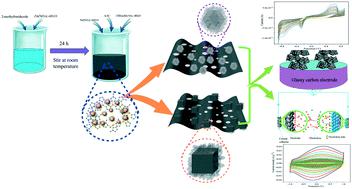当前位置:
X-MOL 学术
›
CrystEngComm
›
论文详情
Our official English website, www.x-mol.net, welcomes your
feedback! (Note: you will need to create a separate account there.)
Ni–Mo modified metal–organic frameworks for high-performance supercapacitance and enzymeless H2O2 detection
CrystEngComm ( IF 2.6 ) Pub Date : 2020-07-06 , DOI: 10.1039/d0ce00666a Yue Li 1, 2, 3 , Kamdem Pascal 4, 5, 6 , Xiao-Juan Jin 1, 2, 3
CrystEngComm ( IF 2.6 ) Pub Date : 2020-07-06 , DOI: 10.1039/d0ce00666a Yue Li 1, 2, 3 , Kamdem Pascal 4, 5, 6 , Xiao-Juan Jin 1, 2, 3
Affiliation

|
In this work, we synthesized A(B)-NixMoy-MOFs@AAC hybrids with different molar ratios of nickel and molybdenum through a liquid phase method and a hydrothermal method. The irregularly shaped Ni/Mo nanoparticles are closely anchored on the surface of the MOFs and the A(B)-NixMoy-MOFs are supported on the acidified activated carbon (AAC) with a size of ∼6 nm. Interestingly, the MOF particles are hexahedral under mild liquid conditions and present a cubic shape under hydrothermal conditions. The A(B)-NixMoy-MOFs@AAC hybrids were tested using transmission electron microscopy (TEM), contact angle measurements, X-ray photoelectron spectroscopy (XPS) and X-ray diffraction (XRD) analytical techniques. The prepared A(B)-NixMoy-MOFs@AAC hybrids were then used as electrode materials. In particular, the A(B)-Ni1Mo0.5-MOFs@AAC electrode exhibited excellent electrochemical properties, with a high specific capacitance (1178 F g−1 at 0.5 A g−1 for the A-Ni1Mo0.5-MOFs@AAC electrode and 1145.7 F g−1 at 0.5 A g−1 for the B-Ni1Mo0.5-MOFs@AAC electrode), and exceptional stability (83.40% maintenance of specific capacitance for the A-Ni1Mo0.5-MOFs@AAC electrode and 78.31% maintenance for the B-Ni1Mo0.5-MOFs@AAC electrode at 15 A g−1). Meanwhile, the as-obtained A(B)-Ni1Mo0.5-MOFs@AAC//AAC achieved a high energy density of 85.83 W h kg−1 to 54.05 W h kg−1 (A-Ni1Mo0.5-MOFs@AAC//AAC) and from 68.26 to 36.07 W h kg−1 (B-Ni1Mo0.5-MOFs@AAC//AAC) based on the total mass of active material at a current density in the range of 1 to 25 A g−1. In addition, the A(B)-NixMoy-MOFs@AAC hybrids were also employed as nonenzymatic sensors for the electrochemical detection of H2O2, and exhibited high sensitivity (0.277 μA μM−1 for the A-Ni1Mo0.5-MOFs@AAC sensor and 0.188 μA μM−1 for the B-Ni1Mo0.5-MOFs@AAC sensor) and noteworthy low detection limits of 0.185 and 0.303 μM based on 3 signal–noise ratios, respectively. Therefore, we expect that the A(B)-Ni1Mo0.5-MOFs@AAC electrodes as electrode materials would have potential applications in supercapacitors and the nonenzymatic detection of H2O2.
中文翻译:

用于高性能超级电容和无酶H2O2检测的Ni-Mo修饰金属有机框架
在这项工作中,我们通过液相法和水热法合成了具有不同摩尔比的镍和钼的A(B)-Ni x Mo y -MOFs @ AAC杂化物。不规则形状的Ni / Mo纳米颗粒紧密地锚定在MOF的表面上,并且A(B)-Ni x Mo y -MOFs负载在大小约为6 nm的酸化活性炭(AAC)上。有趣的是,MOF颗粒在温和的液体条件下为六面体,在水热条件下呈立方体形状。A(B)-Ni x Mo y-MOFs @ AAC杂种使用透射电子显微镜(TEM),接触角测量,X射线光电子能谱(XPS)和X射线衍射(XRD)分析技术进行了测试。然后将制备的A(B)-Ni x Mo y -MOFs @ AAC杂化物用作电极材料。特别地,A(B)-Ni 1 Mo 0.5 -MOFs @ AAC电极表现出优异的电化学性能,具有高的比电容(对于A-Ni 1 Mo 0.5 -MOFs在0.5 A g -1时为1178 F g -1 @AAC电极和对于B-Ni 1 Mo 0.5为0.5 A g -1时的1145.7 F g -1-MOFs @ AAC电极),和特殊的稳定性(对于A-镍比电容的83.40%维护1沫0.5 -MOFs @ AAC电极和78.31%维修为B-的Ni 1沫0.5 -MOFs @ AAC电极在15A g -1)。同时,如此获得的A(B)-Ni 1 Mo 0.5 -MOFs @ AAC // AAC达到了85.83 W h kg -1至54.05 W h kg -1(A-Ni 1 Mo 0.5 -MOFs @ AAC // AAC)和68.26至36.07 W h kg -1(B-Ni 1 Mo 0.5-MOFs @ AAC // AAC),其基于在1至25 A g -1的电流密度下的活性材料的总质量。此外,A(B)-Ni X沫ý -MOFs @ AAC杂种也用作非酶传感器,用于H的电化学检测2 Ò 2,并且表现出高灵敏度(0.277μAμM -1为A的Ni 1沫0.5 -MOFs @ AAC传感器和0.188μAμM -1为B-的Ni 1沫0.5 -MOFs @ AAC传感器)和根据3信号噪声比,分别0.185 0.303和μM的值得注意的低的检出限。因此,我们期望A(B)-Ni 1 Mo0.5 -MOFs @ AAC电极作为电极材料将具有在超级电容器和潜在的应用H的非酶检测2 Ò 2。
更新日期:2020-08-10
中文翻译:

用于高性能超级电容和无酶H2O2检测的Ni-Mo修饰金属有机框架
在这项工作中,我们通过液相法和水热法合成了具有不同摩尔比的镍和钼的A(B)-Ni x Mo y -MOFs @ AAC杂化物。不规则形状的Ni / Mo纳米颗粒紧密地锚定在MOF的表面上,并且A(B)-Ni x Mo y -MOFs负载在大小约为6 nm的酸化活性炭(AAC)上。有趣的是,MOF颗粒在温和的液体条件下为六面体,在水热条件下呈立方体形状。A(B)-Ni x Mo y-MOFs @ AAC杂种使用透射电子显微镜(TEM),接触角测量,X射线光电子能谱(XPS)和X射线衍射(XRD)分析技术进行了测试。然后将制备的A(B)-Ni x Mo y -MOFs @ AAC杂化物用作电极材料。特别地,A(B)-Ni 1 Mo 0.5 -MOFs @ AAC电极表现出优异的电化学性能,具有高的比电容(对于A-Ni 1 Mo 0.5 -MOFs在0.5 A g -1时为1178 F g -1 @AAC电极和对于B-Ni 1 Mo 0.5为0.5 A g -1时的1145.7 F g -1-MOFs @ AAC电极),和特殊的稳定性(对于A-镍比电容的83.40%维护1沫0.5 -MOFs @ AAC电极和78.31%维修为B-的Ni 1沫0.5 -MOFs @ AAC电极在15A g -1)。同时,如此获得的A(B)-Ni 1 Mo 0.5 -MOFs @ AAC // AAC达到了85.83 W h kg -1至54.05 W h kg -1(A-Ni 1 Mo 0.5 -MOFs @ AAC // AAC)和68.26至36.07 W h kg -1(B-Ni 1 Mo 0.5-MOFs @ AAC // AAC),其基于在1至25 A g -1的电流密度下的活性材料的总质量。此外,A(B)-Ni X沫ý -MOFs @ AAC杂种也用作非酶传感器,用于H的电化学检测2 Ò 2,并且表现出高灵敏度(0.277μAμM -1为A的Ni 1沫0.5 -MOFs @ AAC传感器和0.188μAμM -1为B-的Ni 1沫0.5 -MOFs @ AAC传感器)和根据3信号噪声比,分别0.185 0.303和μM的值得注意的低的检出限。因此,我们期望A(B)-Ni 1 Mo0.5 -MOFs @ AAC电极作为电极材料将具有在超级电容器和潜在的应用H的非酶检测2 Ò 2。











































 京公网安备 11010802027423号
京公网安备 11010802027423号